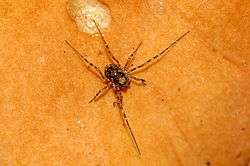Megabunus diadema
Megabunus diadema is a species of harvestman widely distributed in Europe, where it has been found in Iceland, Faroe Islands, Western Norway, Great Britain, Western France, Belgium and Northern Spain.[1]
| Megabunus diadema | |
|---|---|
 | |
| Scientific classification | |
| Kingdom: | |
| Phylum: | |
| Class: | |
| Order: | |
| Suborder: | |
| Family: | |
| Genus: | |
| Species: | M. diadema |
| Binomial name | |
| Megabunus diadema (Fabricius, 1779) | |
| Synonyms | |
|
Phalangium diadema | |
It is commonly found among moss and lichens, and has a cryptic coloration that blends with this habitat, rendering it almost invisible when it is not moving.[2] Its second pair of legs is as long as 35 mm.[3] Its prominent pair of eyes is equipped with a spiny "crown".
M. diadema was shown to feed on chironomid flies.[4]
The gregarines Actinocephalus megabuni and Doliospora repelini (Eugregarinorida), and the mite Leptus beroni were found to parasitize on this species.[5]
During a study of woodland in Scotland, they were found to be most active during March, June to July and December; in montane regions of Wales they only occurred in August, while they were found all year round in English woodland, with a peak from May to August.[6]
The mainly parthenogenetic[1] M. diadema lays three batches of eggs per year, with about 30 eggs per batch that are deposited among leaf litter or on the soil.[7] The larvae, like many in the suborder Eupnoi, have an egg tooth.[8]
Males have 28 chromosomes.[9]
Footnotes
- Stol 2005
- Pinto-da-Rocha et al. 2007: 375
- Pinto-da-Rocha et al. 2007: 494
- Pinto-da-Rocha et al. 2007: 312
- Pinto-da-Rocha et al. 2007: 342,344
- Pinto-da-Rocha et al. 2007: 289
- Pinto-da-Rocha et al. 2007: 431
- Pinto-da-Rocha et al. 2007: 464
- Pinto-da-Rocha et al. 2007: 268
References
- Joel Hallan's Biology Catalog: Phalangiidae
- Stol, Ingvar (2005): Ecology and body size of the parthenogenetic Megabunus diadema (Fabricius, 1779) (Opiliones: Phalangiidae) at Karmøy, Western Norway. Fauna Norvegica 25: 39-44. Abstract
- Pinto-da-Rocha, R., Machado, G. & Giribet, G. (eds.) (2007): Harvestmen - The Biology of Opiliones. Harvard University Press ISBN 0-674-02343-9
External links
- John Partridge: Drawing of M. diadema